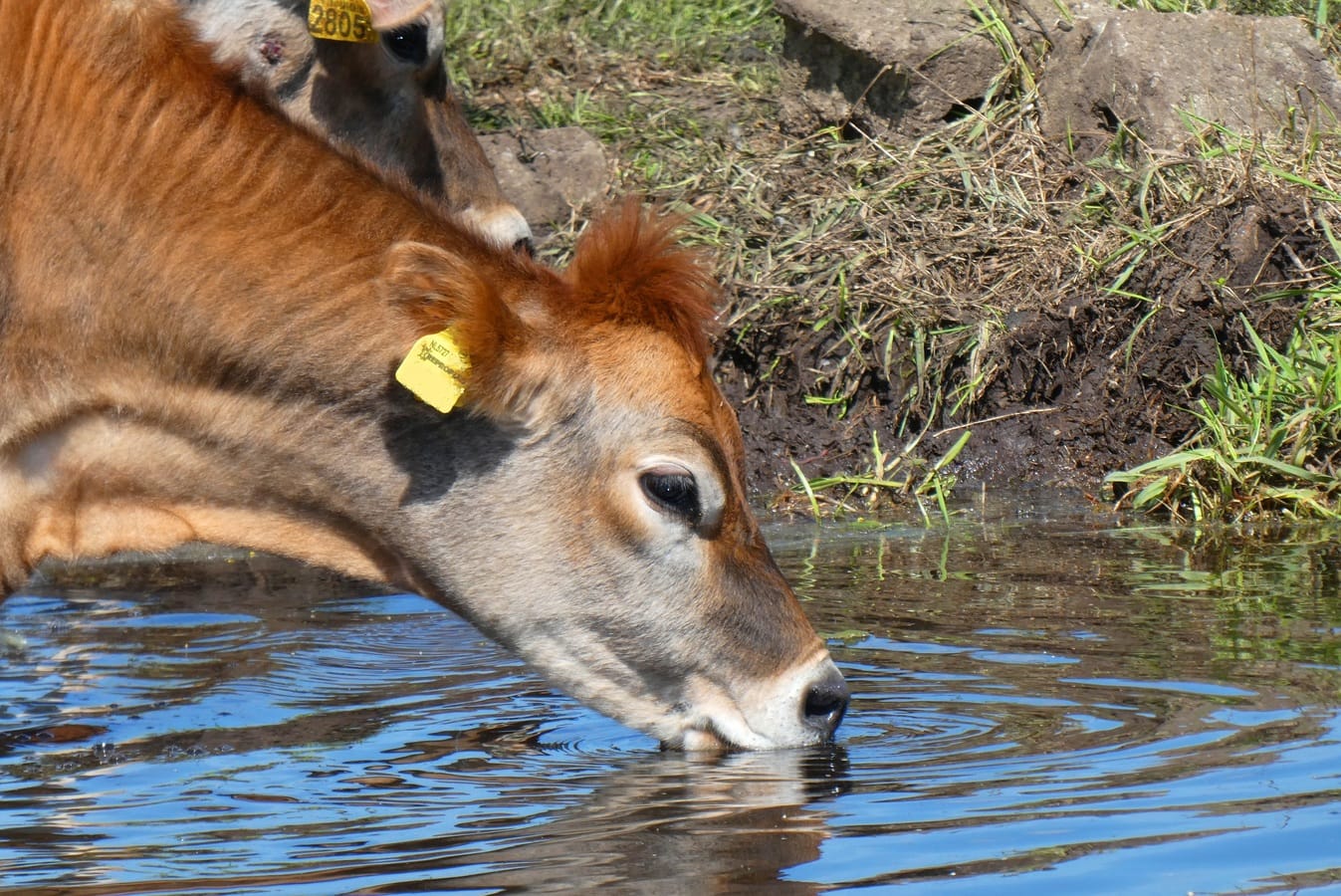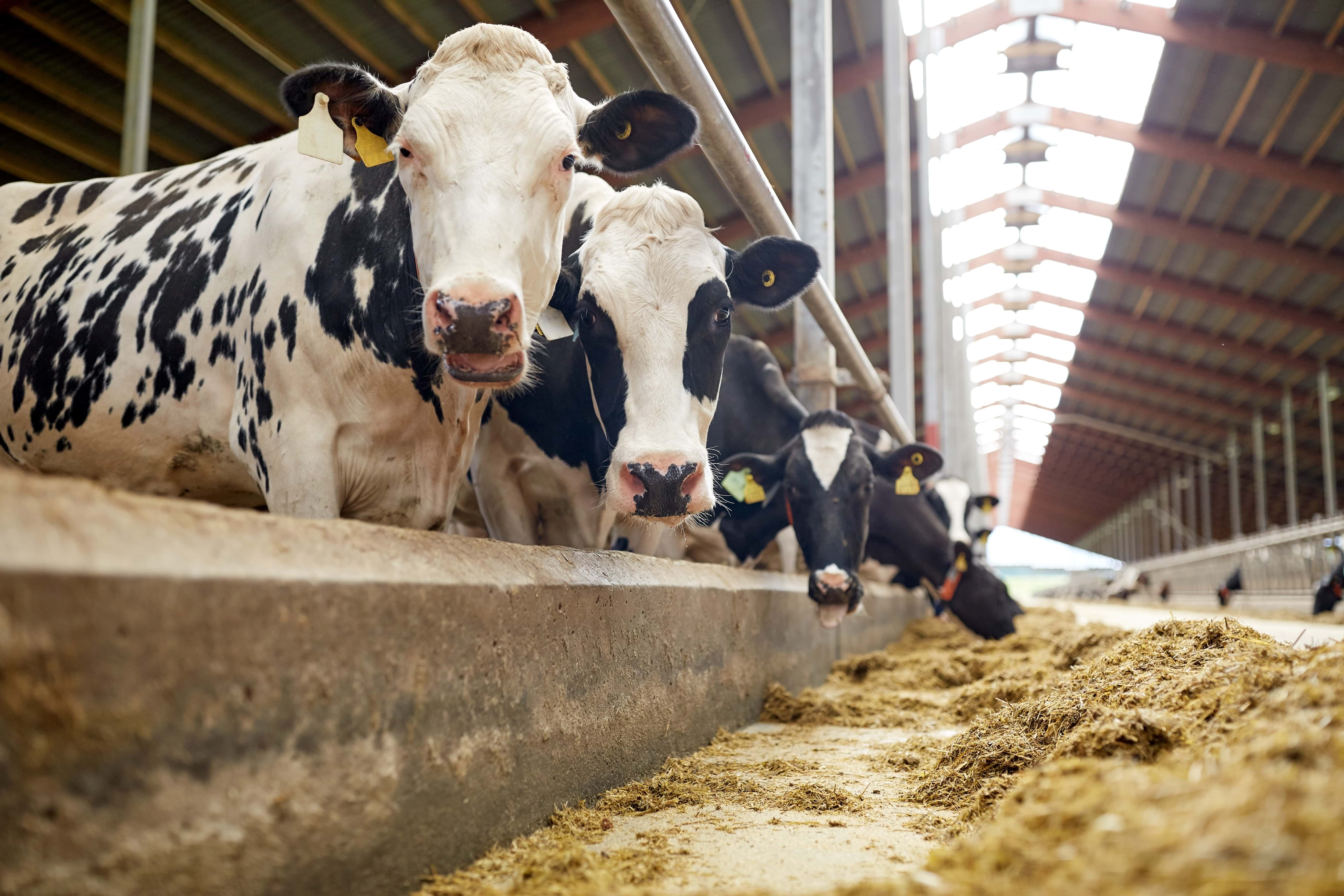It’s important that dairy cows eat nutritious food, to produce high-quality milk.
In this article, we’re going to explore the vast topic of nutrition for your dairy cows and what you can do to ensure that your dairy cows are eating a healthy and balanced diet.
The dairy cow needs a diet that supplies the sufficient nutrients they need to produce high quality and quantity of milk. Carbs, amino acids, fatty acids, minerals, vitamins and water are the major nutrients that the dairy cows’ mammary glands need to produce milk and milk components.
But, it starts right from the early years. To raise a cow with a good future milk yield, it begins with nutrition for the calf and the heifer. If interested read our article on nutrition for calves.
Water
Lactating dairy cows need 60 to 70 litres of water per day to maintain themselves and an additional 4-5 litres for each litre of milk that they produce.

Of course, the amount of water required is dependent on the temperature. An increase in temperature of even 4 degrees Celsius will require more water intake by 6 to 7 litres per day.
High-yielding milk cows will drink even up to 150 or 200 litres of water per day during the hot season.
There are lots of other factors that influence water intakes like dry matter intake, humidity, wind speed, water quality and the temperature and pH value of drinking water.
Carbohydrates
The energy requirements for lactating dairy cows are primarily met by carbs that comprise fibrous and nonfibrous carbohydrates.
Fibrous carbs are primarily found in dry matter while non-fiber carbohydrates consist of sugars, fructans, starch, organic acids and pectin.
They are the largest component in the diet of dairy cattle and comprise up to 70% of the diet of lactating dairy cattle and even more in heifers and cows that aren’t lactating.
The sum of sugars and starch are referred to as nonstructural carbohydrates or NSC. Balancing the fiber and NFC to optimise the intake of energy and rumen health is one of the main challenges of dairy nutrition.
Fiber in the diet boosts the health of the rumen. Fiber when present in the rumen, especially fiber which is derived from food that hasn’t been chopped or ground, helps to stimulate motility, cud-chewing and the free flow of saliva.
All these keep the environment in the rumen favourable by boosting the production of salivary buffers and a good flow of fluid movement through the rumen.
These salivary buffers, in turn, maintain the rumen pH in a desirable range and the high rate of fluid increases the efficiency of microbial energy and protein yield.
Sources of carbs include forages, roughages, grains and sugars. Forages include hay, hay-crop silage, grain-based silage like corn, or small grains which are digested by cellulolytic bacteria. This results in the production of acetic and butyric acid.
Protein and amino acids
Protein is typically measured in the feed as crude protein which is defined as the percentage of nitrogen (N) in a feed, multiplied by 6.25.
This value of 6.25 is based on the fact that feed proteins consist of approximately 16% N.
Crude proteins not only comprise true protein but also other compounds containing N like amino acids, dipeptides, nucleic acids, NH3 and other non-protein nitrogen compounds.
Cattle will not have a protein requirement exactly, instead, have an amino acid requirement and true proteins are defined as chains of amino acids.
Cows use amino acids to produce enzymes, milk proteins, immunoglobulins, muscle and various organs and tissues in the body.
There are hundreds of amino acids in nature. An amino acid comprises both amino and acid groups. In most animals, there are 10 essential amino acids and the rest aren’t essential.
Some amino acids like lysine and methionine are considered limiting for production and are based on the diet fed to the cattle. Limiting means that protein synthesis and yield are limited by the amount of these amino acids in the cow’s diet.
Corn is deficient in lysine and soybean is deficient in methionine.
And supplementing other amino acids is not to make up for the deficiency in lysine and methionine. Cow diets that are high in grass silage and pasture with barley or oats are a good way to get enough of these two amino acids into your cows' diets.
Fat
Fat is the most energy-dense nutrient. It has 2.25 times as much energy as carbs or proteins.
Fats can be further divided into two main types – glycerol and non-glycerol.
Non-glycerol fats have very little nutritive value and include waxes and sterols.
Glycerol-type fats include triglycerides, phospholipids and glycolipids which provide a lot of nutrition.
How to feed fat:
You must remember that almost all feeds, except for water and minerals, have fat in them.
Carbs have about 3% fat and immature grasses have more than 5% fat.
Proteins can have anywhere between 3% - 10% fat.
Oilseeds like canola, flax soybeans and cottonseed have 20% fat while sunflower or pumpkin seeds have up to 45% fat.
The feed should not have more than 8% fat in the total dry matter.
If fat is fed in the right way, cows in early lactation will yield higher quantities of milk and sometimes even enhanced milk fat but a reduced concentration of milk protein.
Cows will also experience better fertility either through a greater balance in energy or via better hormone concentrations involved in reproduction.

Minerals
Calcium requirements of milking cows are higher compared to other animals or even compared to non-lactating cows. Because milk contains high amounts of calcium.
That’s why inorganic sources of calcium like calcium carbonate or di-calcium phosphate should be added to the ration of lactating dairy cows.
In general, diets with a large portion of forage from legumes will have a minimum calcium concentration requirements of about 0.75% while diets with forages from grass will have minimum calcium concentration requirements of 0.45%.
There are also other macrominerals that a cow needs like sodium, potassium, chloride, magnesium and sulfur.
Out of all these, it is generally sodium that needs to be supplemented. If your cows are having a salt deficiency, they will exhibit symptoms like licking and chewing fences or even urine drinking.
Non-lactating cows need 1.5g/100 kg body weight per day. Large breed dairy cows need 9-10 g per day.
Supplemental magnesium may also need to be fed if there is a deficiency.
Dairy cows do not need inorganic sulfur.
In short, the recommended dietary concentrations for dairy cow diets are 0.23% sodium, 0.29% chloride, 1.1% potassium, 0.21% magnesium and 0.21% sulfur.
When it comes to trace minerals, it is usually only selenium and copper that are likely to be deficient.
- Recommended dietary copper concentrations in cattle diets are 10 – 15 mg/kg dry matter
- Recommended manganese concentrations are 15 – 25 mg/kg dry matter
- Recommended zinc concentrations are 23 – 63 mg/kg dry matter
- Recommended iodine concentration is 0.6 mg/kg dry matter
Vitamins
Vitamin A or retinol does not naturally exist in any plant material. Vitamin A activity from natural sources comes from B-carotene which is found in plants and fresh forage.
Vitamin D is required for the absorption and metabolism of calcium and phosphorous. The recommended amount of Vitamin D supplements for adult dairy cows is 30 IU/kg body weight which will be supplied with diets that have 1000 kg dry matter.
Vitamin E is abundantly found in fresh forage so it’s usually not something that has to be given as supplements. The rates of Vitamin E usually depend on the stage of gestation. It’s also non-toxic so there is very little risk of excessive Vitamin E.
The topic of nutrition for cows is varied and vast. If interested, check out our detailed overview about nutrition for ruminants.
Until we meet again, happy farming.
- The Dedicated Team of Pasture.io, 2020-12-07